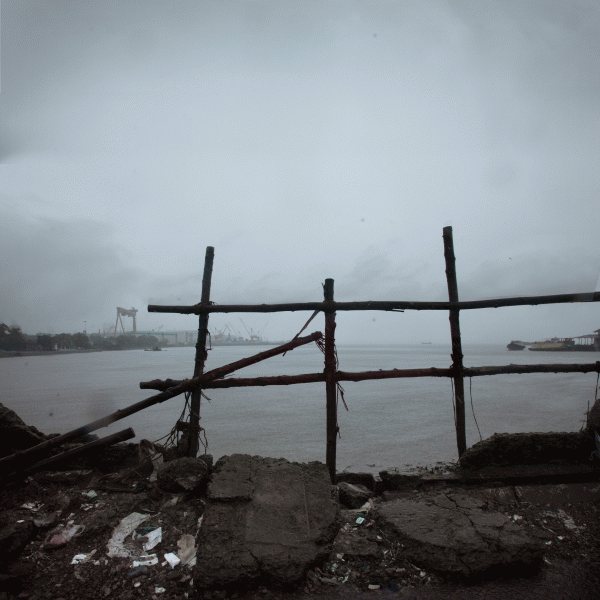It has been three days of nonstop monsoon, so much so that it has been hard to walk about Mazagaon, talk to people or work on photo/video material of any kind. Even my journals are soaked!

After two weeks in Mumbai, I started missing the ocean and the seascape. It is fascinating on both an anthropological and historical level how this city, which was forcefully built on an archipelago of islands inhabited by fishermen, which exists with the sole purpose of creating a powerful port and a center for maritime commerce, exist today cut out from the water, its coastline, and seascape by a 7-meter high wall.
Walled in, I found myself missing the seascape and seeking those few access to water available, disregarding floods and the heavy reins.

I found access to the sea via the Fisherman’s Wharf. The pears were deserted as any activities on the harbor were shut down due to the monsoon. The tight is high, the ocean is overflowing with water from above, and the ships are almost suspended, waiting for port access and better weather.
All fishing activities are suspended, and everything is waterlogged, the streets, the boat, and possibly my underwear.

Let’s take a few steps back. When the British took over the islands where Mumbai now is, they first created “forts” to protect their investment, then proceeded to cut the mangrove and fill the space between the island, changing their morphology and building the experiment that is now the city of Mumbai. The port was also claimed from the ocean, and the Kori (fisherman community which initially inhabited this island ) the same way, and finally divided from the city by a massive 7-meter high wall along the west side of Mumbai. A border and a colonial statement still stand between the city and the sea.

That is not all; the southern tip of the now peninsula of Mumbai is also walled off as it belongs to the military and is, therefore, inaccessible to the public. In addition, all the lands upon which south Mumbai is built belong to the Port Authority ( former East Indies Company, which received it as a gift from the British Empire), which leases the lands to the city.
In fact, at the moment, most Mumbai monuments, museums, and historical landmarks stand on Port Authority’s land, leases that are now expiring, creating total chaos.
Now, if this is not the inheritance of colonial fuckery I don’t know what is, but this is another story. Meanwhile, here are some articles to explore.
Mumbai’s Iconic Taj Hotel’s Parent To Challenge Retrospective Demand By Port Trust
https://www.bqprime.com/business/mumbais-iconic-taj-hotels-parent-to-challenge-retrospective-demand-by-port-trust
Mumbai Port Trust may go the mill land way
https://www.hindustantimes.com/mumbai-news/mumbai-port-trust-may-go-the-mill-land-way/story-oY1P9L2QtqhyOpEpvU7z6J.html
In essence, no real point of access or intersection exists where the population can dialogue with the sea and its nature.
Leaving aside the lack of poetry, how fucked up is this!
Lack of access means a lack of knowledge, a lack of respect and understanding for one surroundings, and, most importantly, a lack of ownership over one surroundings.
I believe this disconnect has shifted Mumbai inhabitants to look at the sea as a resource at best and its city coastline as something foul and secondary to oneself or the city overall.
It is not surprising then to imagine that the only exiting oceanfront on the east side of the peninsula is now under construction not to create better public access to the sea but to build a high-speed highway that will travel along all the city’s costs and beyond, severing even more Mumbai from its seascape and permanently boxing in the city out of ocean access, its communities, its nature, and its expansive horizon.
A design conceived in 1962 when urban engineering had no knowledge nor interest in evaluating the ecological damage and social disruption such project could inflict on the city and its surroundings.
Coastal Road (Mumbai)
https://en.wikipedia.org/wiki/Coastal_Road_(Mumbai)
High-speed coastal road corridor: A sea-change in the way Mumbai drives
https://indianexpress.com/article/cities/mumbai/high-speed-coastal-road-corridor-a-sea-change-in-the-way-mumbai-drives-8586293/
All you need to know about this Rs 12,700-crore Mumbai road ..
http://timesofindia.indiatimes.com/articleshow/86473603.cms?utm_source=contentofinterest&utm_medium=text&utm_campaign=cppst
As I look at its morphology, it is evident this must have been an incredibly beautiful place, and it could still be if enough effort is put into it.
Currently, the cost lien is built up with cranes, dry docks, landing docks, factories, and two refineries, non of which looks very environmentally friendly.
This once active port is a shadow of itself and somewhat run-down today. Across the bay, the new Bombay Harbor, the new port, larger, newer, bigger, has taken most of the business away from the old docks and the communities like Mazagaon that live off it.
In the bally of the Bey stands, miraculously squeezed between the old and new ports, the only area where mangroves still grow.
As everything stands still, looking like a ghost, it feels like the sea grieves what has been lost here, hanging on to stay alive, welcoming the standstill the monsoon provides.
Attached at the end of the post, you can find some books I have been reading to prepare for the project.


Art walks Mumbai
https://www.artandwonderment.in/
https://theinheritageproject.wordpress.com/author/theinheritageproject/
Books on Mazgaon
My Own Mazagon: The History of a Little Island in the Bombay Archipelago
https://www.amazon.in/My-Own-Mazagon-History-Archipelago/dp/9385509632/ref=sr_1_1?crid=140LYIPGWGNFS&keywords=mazgaon&qid=1689359762&sprefix=mazgaon%2Caps%2C349&sr=8-1
Books on Mumbai or Indian heritage
Bombay, the cities within. – By Sharada Dwivedi & Rahul Mehrotra
Bombay Before Mumbai: Essays in Honour. – by Prashant Kidambi (Editor, Author), Manjiri Kamat (Editor), Rachel Dwyer (Editor)
Orientalism – by Edward W. Said
British social life in India 1608-1937 – By Dennis Kincaid
Colonial self-fashioning in British India c.1785-1845 – By Prasannajit de silva
India Cast Costoms – By L.S.S. O, Malley
The Great Mysore Bhagavata. Complete Study of Manuscript from the Binney Collection in the San Diego Museum of Art – By B.N. Goswamy
Also check Professor B.N. Goswamy video lecture on YouTube
Boston-Jobson. A glossary of anglo-indian colloquial words and phrases and of kindred terms – By Col. Henry Yule and A.C. Burnell
Culture Religion and Home-making in and Beyond South Asia – by James Ponniah.
Marg Magazine ( old magazine )

